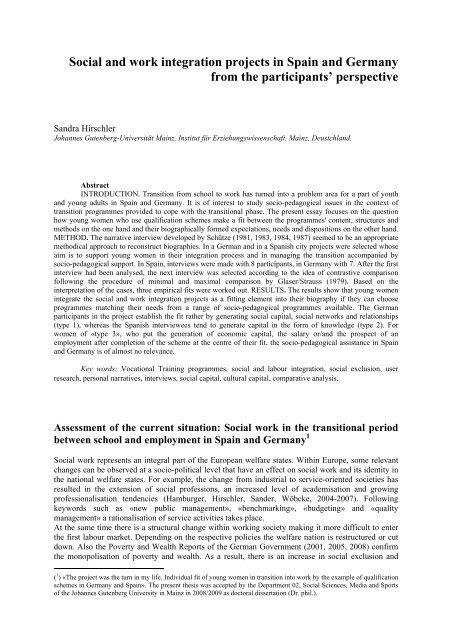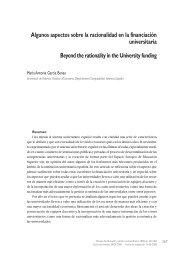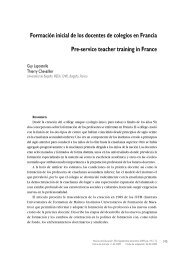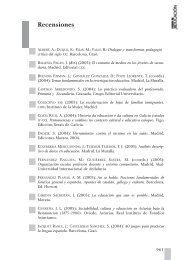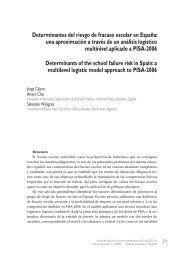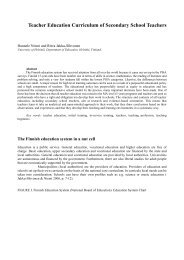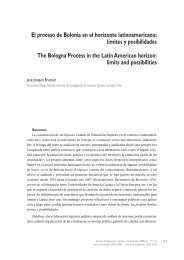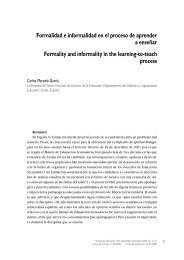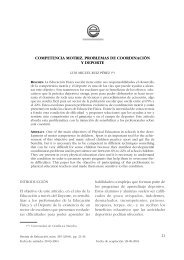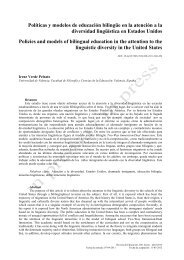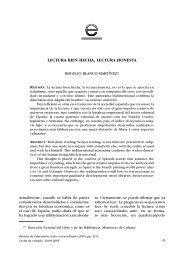Social and work integration projects in Spain and Germany from the ...
Social and work integration projects in Spain and Germany from the ...
Social and work integration projects in Spain and Germany from the ...
You also want an ePaper? Increase the reach of your titles
YUMPU automatically turns print PDFs into web optimized ePapers that Google loves.
<strong>Social</strong> <strong>and</strong> <strong>work</strong> <strong><strong>in</strong>tegration</strong> <strong>projects</strong> <strong>in</strong> Spa<strong>in</strong> <strong>and</strong> <strong>Germany</strong><strong>from</strong> <strong>the</strong> participants’ perspectiveS<strong>and</strong>ra HirschlerJohannes Gutenberg-Universität Ma<strong>in</strong>z. Institut für Erziehungswissenschaft. Ma<strong>in</strong>z, Deustchl<strong>and</strong>.AbstractINTRODUCTION. Transition <strong>from</strong> school to <strong>work</strong> has turned <strong>in</strong>to a problem area for a part of youth<strong>and</strong> young adults <strong>in</strong> Spa<strong>in</strong> <strong>and</strong> <strong>Germany</strong>. It is of <strong>in</strong>terest to study socio-pedagogical issues <strong>in</strong> <strong>the</strong> context oftransition programmes provided to cope with <strong>the</strong> transitional phase. The present essay focuses on <strong>the</strong> questionhow young women who use qualification schemes make a fit between <strong>the</strong> programmes' content, structures <strong>and</strong>methods on <strong>the</strong> one h<strong>and</strong> <strong>and</strong> <strong>the</strong>ir biographically formed expectations, needs <strong>and</strong> dispositions on <strong>the</strong> o<strong>the</strong>r h<strong>and</strong>.METHOD. The narrative <strong>in</strong>terview developed by Schütze (1981, 1983, 1984, 1987) seemed to be an appropriatemethodical approach to reconstruct biographies. In a German <strong>and</strong> <strong>in</strong> a Spanish city <strong>projects</strong> were selected whoseaim is to support young women <strong>in</strong> <strong>the</strong>ir <strong><strong>in</strong>tegration</strong> process <strong>and</strong> <strong>in</strong> manag<strong>in</strong>g <strong>the</strong> transition accompanied bysocio-pedagogical support. In Spa<strong>in</strong>, <strong>in</strong>terviews were made with 8 participants, <strong>in</strong> <strong>Germany</strong> with 7. After <strong>the</strong> first<strong>in</strong>terview had been analysed, <strong>the</strong> next <strong>in</strong>terview was selected accord<strong>in</strong>g to <strong>the</strong> idea of contrastive comparisonfollow<strong>in</strong>g <strong>the</strong> procedure of m<strong>in</strong>imal <strong>and</strong> maximal comparison by Glaser/Strauss (1979). Based on <strong>the</strong><strong>in</strong>terpretation of <strong>the</strong> cases, three empirical fits were <strong>work</strong>ed out. RESULTS. The results show that young women<strong>in</strong>tegrate <strong>the</strong> social <strong>and</strong> <strong>work</strong> <strong><strong>in</strong>tegration</strong> <strong>projects</strong> as a fitt<strong>in</strong>g element <strong>in</strong>to <strong>the</strong>ir biography if <strong>the</strong>y can chooseprogrammes match<strong>in</strong>g <strong>the</strong>ir needs <strong>from</strong> a range of socio-pedagogical programmes available. The Germanparticipants <strong>in</strong> <strong>the</strong> project establish <strong>the</strong> fit ra<strong>the</strong>r by generat<strong>in</strong>g social capital, social net<strong>work</strong>s <strong>and</strong> relationships(type 1), whereas <strong>the</strong> Spanish <strong>in</strong>terviewees tend to generate capital <strong>in</strong> <strong>the</strong> form of knowledge (type 2). Forwomen of «type 3», who put <strong>the</strong> generation of economic capital, <strong>the</strong> salary or/<strong>and</strong> <strong>the</strong> prospect of anemployment after completion of <strong>the</strong> scheme at <strong>the</strong> centre of <strong>the</strong>ir fit, <strong>the</strong> socio-pedagogical assistance <strong>in</strong> Spa<strong>in</strong><strong>and</strong> <strong>Germany</strong> is of almost no relevance.Key words: Vocational Tra<strong>in</strong><strong>in</strong>g programmes, social <strong>and</strong> labour <strong><strong>in</strong>tegration</strong>, social exclusion, userresearch, personal narratives, <strong>in</strong>terviews, social capital, cultural capital, comparative analysis.Assessment of <strong>the</strong> current situation: <strong>Social</strong> <strong>work</strong> <strong>in</strong> <strong>the</strong> transitional periodbetween school <strong>and</strong> employment <strong>in</strong> Spa<strong>in</strong> <strong>and</strong> <strong>Germany</strong> 1<strong>Social</strong> <strong>work</strong> represents an <strong>in</strong>tegral part of <strong>the</strong> European welfare states. With<strong>in</strong> Europe, some relevantchanges can be observed at a socio-political level that have an effect on social <strong>work</strong> <strong>and</strong> its identity <strong>in</strong><strong>the</strong> national welfare states. For example, <strong>the</strong> change <strong>from</strong> <strong>in</strong>dustrial to service-oriented societies hasresulted <strong>in</strong> <strong>the</strong> extension of social professions, an <strong>in</strong>creased level of academisation <strong>and</strong> grow<strong>in</strong>gprofessionalisation tendencies (Hamburger, Hirschler, S<strong>and</strong>er, Wöbcke, 2004-2007). Follow<strong>in</strong>gkeywords such as «new public management», «benchmark<strong>in</strong>g», «budget<strong>in</strong>g» <strong>and</strong> «qualitymanagement» a rationalisation of service activities takes place.At <strong>the</strong> same time <strong>the</strong>re is a structural change with<strong>in</strong> <strong>work</strong><strong>in</strong>g society mak<strong>in</strong>g it more difficult to enter<strong>the</strong> first labour market. Depend<strong>in</strong>g on <strong>the</strong> respective policies <strong>the</strong> welfare nation is restructured or cutdown. Also <strong>the</strong> Poverty <strong>and</strong> Wealth Reports of <strong>the</strong> German Government (2001, 2005, 2008) confirm<strong>the</strong> monopolisation of poverty <strong>and</strong> wealth. As a result, <strong>the</strong>re is an <strong>in</strong>crease <strong>in</strong> social exclusion <strong>and</strong>( 1 ) «The project was <strong>the</strong> turn <strong>in</strong> my life. Individual fit of young women <strong>in</strong> transition <strong>in</strong>to <strong>work</strong> by <strong>the</strong> example of qualificationschemes <strong>in</strong> <strong>Germany</strong> <strong>and</strong> Spa<strong>in</strong>». The present <strong>the</strong>sis was accepted by <strong>the</strong> Department 02, <strong>Social</strong> Sciences, Media <strong>and</strong> Sportsof <strong>the</strong> Johannes Gutenberg University <strong>in</strong> Ma<strong>in</strong>z <strong>in</strong> 2008/2009 as doctoral dissertation (Dr. phil.).
Focuss<strong>in</strong>g on <strong>the</strong> transition <strong>from</strong> <strong>the</strong> selective school system to <strong>the</strong> st<strong>and</strong>ardized system ofvocational tra<strong>in</strong><strong>in</strong>g it can be noted that fail<strong>in</strong>g <strong>in</strong> transition is considered foremost an <strong>in</strong>dividual risk. Ifyoung people fail to manage <strong>the</strong> transition <strong>from</strong> school to <strong>work</strong>, job preparatory programmes such as«tra<strong>in</strong><strong>in</strong>g-accompany<strong>in</strong>g assistance», part-time «<strong>in</strong>-house tra<strong>in</strong><strong>in</strong>g» <strong>and</strong> «vocational tra<strong>in</strong><strong>in</strong>g <strong>in</strong> noncompanyfacilities» will be adopted. In many cases, job preparatory programmes <strong>work</strong> as a «wait<strong>in</strong>glist» <strong>and</strong> are meant to compensate educational <strong>and</strong> social deficits (Esp<strong>in</strong>g-Andersen, 1990).The rudimentary type of regime, however, only provides a few <strong>in</strong>stitutionalized <strong>and</strong>guaranteed rights. Spanish social security funds are a mixed system of public <strong>and</strong> private elements.They were ma<strong>in</strong>ly characterized by political, economic <strong>and</strong> social circumstances develop<strong>in</strong>g highlyunequally (Schmid, 2002, p. 226). In addition, by European comparison, legal entitlement to socialsecurity was <strong>in</strong>troduced only late <strong>and</strong> <strong>in</strong> a marg<strong>in</strong>alized way.Labour market programmes such as <strong>the</strong> Programas de garantía social, Escuelas Talleres <strong>and</strong>Casas de Oficio are offered to young people if <strong>the</strong> (smooth) transition <strong>from</strong> school to <strong>the</strong> (first) labourmarket fails (cf. Vogel, 2007). However, <strong>the</strong> transition <strong>from</strong> school to employment is, <strong>in</strong> comparisonto <strong>Germany</strong>, under-<strong>in</strong>stitutionalized <strong>and</strong> of rudimentary design. The lack of vocational tra<strong>in</strong><strong>in</strong>gstructures, lack<strong>in</strong>g rights to social security benefits <strong>and</strong> highly segmented labour markets result <strong>in</strong>youths <strong>and</strong> young adults longer depend<strong>in</strong>g on <strong>and</strong> be<strong>in</strong>g stronger anchored <strong>in</strong> <strong>the</strong>ir families. O<strong>the</strong>rconsequences are long wait<strong>in</strong>g times, high youth unemployment <strong>and</strong> many young people «employed»<strong>in</strong> <strong>the</strong> <strong>in</strong>formal sector. In some countries of <strong>the</strong> rudimentary type, issues such as youth unemploymentare ra<strong>the</strong>r common compared to o<strong>the</strong>r types of regime. Due to <strong>the</strong> high numbers of unemployed youthit is primarily not considered such a «social problem» as <strong>in</strong> o<strong>the</strong>r regimes (Wal<strong>the</strong>r, 2006, p. 213).Compar<strong>in</strong>g <strong>the</strong> two types of regime reveals different ways of cop<strong>in</strong>g with <strong>the</strong> transition toemployment. In <strong>the</strong> conservative-cooperational type of regime <strong>the</strong> employment sector is highlyregulated <strong>and</strong> job-centred. Dw<strong>in</strong>dl<strong>in</strong>g possibilities of obta<strong>in</strong><strong>in</strong>g employment <strong>in</strong>volve <strong>the</strong> risk for jobbiographic one-way-streets <strong>and</strong> mechanisms of social exclusion. Young people are allocated toexist<strong>in</strong>g st<strong>and</strong>ardized job positions. Only those dispos<strong>in</strong>g of high educational capital (cf. Bourdieu,1983) have <strong>the</strong> choice.In rudimentary, under-<strong>in</strong>stitutionalized types of regime such as <strong>the</strong> Spanish system <strong>the</strong>employment sector is not as highly regulated <strong>and</strong> job-centred as <strong>in</strong> conservative regimes. Thetransition <strong>from</strong> school to employment is characterized by longer wait<strong>in</strong>g periods dur<strong>in</strong>g which youngpeople depend foremost on <strong>the</strong>ir parents <strong>and</strong> family. In Spa<strong>in</strong>, youth unemployment rates aresignificantly higher (02/2009: 31.8%) than <strong>in</strong> <strong>Germany</strong> (02/2009: 10.3%; Eurostat, 2009). Thereseems to be less exclusion of young people because youth unemployment is first of all expla<strong>in</strong>ed bystructural deficits <strong>and</strong> <strong>the</strong> result<strong>in</strong>g structure-related concept of disadvantage. Thus <strong>the</strong> consequencesof unemployment <strong>and</strong> job <strong>in</strong>stability are softened by «social normalisation <strong>and</strong> approv<strong>in</strong>g acceptance»(Kieselbach/Beelmann, 2003, 35).When turn<strong>in</strong>g <strong>from</strong> <strong>the</strong> types of regime to <strong>the</strong> concrete «country level» it becomes visible that<strong>the</strong> (subjective) extent of social <strong>and</strong> economic exclusion is dist<strong>in</strong>ctly lower <strong>in</strong> Spa<strong>in</strong> than <strong>in</strong> <strong>Germany</strong>(Kieselbach, Beelmann, 2003). In Spa<strong>in</strong>, young people stay longer with <strong>the</strong>ir families than <strong>in</strong> <strong>Germany</strong>(M<strong>in</strong>isterio de Trabajo y Asuntos <strong>Social</strong>es, 2007). There is a «postpon<strong>in</strong>g of <strong>in</strong>dependence of youngpeople until <strong>the</strong>ir late 20ies» (Laparra/Aguilar, 1998, 402). In Spa<strong>in</strong>, o<strong>the</strong>r than <strong>in</strong> <strong>Germany</strong>, supportby <strong>the</strong> family seems to be a central <strong>in</strong>stance of assistance 4 . The «postponement of <strong>in</strong>dependence’ isalso recognizable by <strong>the</strong> fact that households often have to comb<strong>in</strong>e a stable <strong>in</strong>come (mostly by <strong>the</strong>male adult breadw<strong>in</strong>ner) with low (pension, unemployment benefit) <strong>and</strong> <strong>in</strong>stable <strong>in</strong>comes (part-timejob, temporary <strong>work</strong>). 5With respect to <strong>the</strong> transition <strong>from</strong> school to employment it can be noted that <strong>the</strong> Germaneducational system provides far more selective preparation for vocational tra<strong>in</strong><strong>in</strong>g than <strong>the</strong> Spanishsystem. In <strong>Germany</strong>, transition <strong>in</strong>to vocational tra<strong>in</strong><strong>in</strong>g, for example <strong>the</strong> system of dual education(comb<strong>in</strong>ation of <strong>in</strong>-firm tra<strong>in</strong><strong>in</strong>g <strong>and</strong> vocational school), is characterized by relatively strict( 4 ) For example, <strong>in</strong> <strong>the</strong> context of a study half of all young Spanish adults expla<strong>in</strong>ed that <strong>the</strong>y only obta<strong>in</strong>ed a job throughsocial capital <strong>in</strong> form of family <strong>and</strong> friends (Field, 2003, 52). When compar<strong>in</strong>g <strong>the</strong> life situations of youths <strong>and</strong> young adults<strong>in</strong> both regimes it can be noted that <strong>in</strong> <strong>Germany</strong> <strong>the</strong> ma<strong>in</strong> source of <strong>in</strong>come of young adults is labour (Sardei-Biermann/Kanalas, 2006, 70f), whereas <strong>in</strong> Spa<strong>in</strong> it is <strong>the</strong> parents. In Spa<strong>in</strong>, only 15% of <strong>the</strong> youths <strong>and</strong> young adults receivestate aid (Moral, 2002, 264).( 5 ) For example, 64.85 % of <strong>the</strong> 15 to 24 year old pursue a temporary job <strong>in</strong> Spa<strong>in</strong> – compared to an average of 38.7% <strong>in</strong> <strong>the</strong>EU (Navarrete Moreno, 2007, 14 f.).
equirements <strong>and</strong> st<strong>and</strong>ards for access <strong>and</strong> direct transition to labour is not common. In Spa<strong>in</strong>, <strong>the</strong>transition <strong>from</strong> school to employment is more pervious than <strong>in</strong> <strong>the</strong> German system, formalqualifications are less important than <strong>in</strong>formal net<strong>work</strong>s.Overall, it can be stated that <strong>in</strong> <strong>the</strong> Spanish society – <strong>in</strong> contrast to <strong>Germany</strong> – <strong>the</strong>re is a comb<strong>in</strong>ationof high social uncerta<strong>in</strong>ty <strong>and</strong> low social exclusion.The short outl<strong>in</strong>e of <strong>the</strong> two different types of regime <strong>and</strong> countries illustrates <strong>the</strong> strongimpact of sociopolitical situations on (nationally designed) social <strong>work</strong> <strong>and</strong> consequently on <strong>the</strong>significance of social <strong>work</strong>ers <strong>in</strong> society. Simultaneously, «<strong>the</strong> practice <strong>in</strong> every country [meets with]certa<strong>in</strong> basic issues that, <strong>in</strong> <strong>the</strong> first place, enable communication <strong>and</strong> allow to recognise <strong>the</strong> benefit ofcomparative perspectives» (Lorenz, 1996, 54). This avoidable paradox gives rise to <strong>the</strong> questionwhe<strong>the</strong>r social <strong>work</strong> <strong>in</strong> its activities «on <strong>the</strong> job» – which is framed by nation state sociopoliticalcircumstances –, when <strong>work</strong><strong>in</strong>g with deprived <strong>and</strong> excluded youths <strong>and</strong> young adults, really takes sucha different approach as it may be assumed given <strong>the</strong> divergent frame<strong>work</strong> (Treptow, 2004), or whe<strong>the</strong>rit follows similar mechanisms at <strong>the</strong> practical level, as stated by Walter Lorenz (1996).Based on <strong>the</strong> changes described above, <strong>the</strong> presumption is near that also social <strong>work</strong> «on <strong>the</strong>job throughout Europe» will have to adapt to <strong>the</strong> chang<strong>in</strong>g conditions. Accord<strong>in</strong>g to ThomasRauschenbach (1994), «solidarity» <strong>and</strong> social capital will disappear «<strong>from</strong> <strong>the</strong> sphere of humanrelations» due to <strong>the</strong> transformation <strong>and</strong> modernisation processes described. Someth<strong>in</strong>g else will haveto replace <strong>the</strong>m. Follow<strong>in</strong>g Rauschenbach, this may mean an <strong>in</strong>crease <strong>in</strong> importance of social <strong>work</strong>. Asa new form of «staged communities» it is [...] part of a public resource of <strong>the</strong> «social» that has beenproduced». In this sense, social <strong>work</strong> is an «<strong>in</strong>strument to ensure person-related social services <strong>in</strong> formof a secondary <strong>in</strong>stitutionalisation, i. e. an answer of society to socially produced social disparities <strong>and</strong>needs» (Rauschenbach, 1994, p. 96). What is needed is a paradigm shift, a change towards adequatesocial <strong>work</strong> correspond<strong>in</strong>g to <strong>the</strong> given social circumstances. The service-oriented approach seems tobe useful as through its radical turn to <strong>the</strong> user perspective 6 it offers <strong>the</strong> chance to realize a paradigmshift <strong>in</strong> <strong>the</strong> direction of adequate social <strong>work</strong> correspond<strong>in</strong>g to <strong>the</strong> given social circumstances.The research designThe brief description of <strong>the</strong> conservative <strong>and</strong> rudimentary type of regime has shown that social <strong>work</strong> istied to nation state frame<strong>work</strong>s but that, however, <strong>the</strong> latter are fac<strong>in</strong>g similar challenges throughoutEurope. Therefore, social <strong>work</strong> as a «response of society to socially produced social disparities <strong>and</strong>needs», as Rauschenbach puts it, is also a European social response to <strong>the</strong> challenges that need to becoped with. At <strong>the</strong> centre of social <strong>work</strong> is <strong>the</strong> <strong>in</strong>dividual person, called <strong>the</strong> «user» <strong>in</strong> <strong>the</strong> term<strong>in</strong>ologyof service-related social <strong>work</strong>. Consequently, <strong>the</strong> perspective of <strong>the</strong> user – exemplary <strong>the</strong> user of social<strong>work</strong> <strong>in</strong> <strong>the</strong> transitional period between school <strong>and</strong> employment – is at <strong>the</strong> centre of <strong>the</strong> study. Thesocial <strong>work</strong> effected <strong>in</strong> <strong>the</strong> frame of job assistance <strong>projects</strong> for young people on <strong>the</strong> threshold betweenschool <strong>and</strong> employment has been an obvious example for a practice area of social education. At thisthreshold, deprivation <strong>and</strong> exclusion become especially clear, for example, young people withoutsufficient capital «shipwreck» at this po<strong>in</strong>t. In most cases <strong>the</strong>ir possibilities to <strong>in</strong>dependently manage<strong>the</strong> transition to <strong>the</strong> first labour market are quite limited. Moreover, this po<strong>in</strong>t of transition toemployment represents a special challenge to social <strong>work</strong> <strong>in</strong> <strong>the</strong> service-oriented societies as labour ishighly valued <strong>and</strong> <strong>the</strong> «normal employment» is appreciated as a highly desirable good which can,however, often not be achieved due to lack<strong>in</strong>g job opportunities. <strong>Social</strong> <strong>work</strong> <strong>in</strong> job-preparatoryprogrammes faces <strong>the</strong> dilemma of tra<strong>in</strong><strong>in</strong>g young people for jobs without a secure future economicbenefit, i. e. possible employments. In do<strong>in</strong>g so, <strong>the</strong> activities of social <strong>work</strong> have <strong>the</strong> task to reduce<strong>in</strong>equalities <strong>and</strong> to support deprived youths <strong>and</strong> young adults <strong>in</strong> achiev<strong>in</strong>g «successful transitions».( 6 ) The concept of <strong>the</strong> user applied <strong>in</strong> <strong>the</strong> study refers to <strong>the</strong> service-<strong>the</strong>oretical research approach. Users of social <strong>work</strong> arepeople who are <strong>in</strong> direct <strong>in</strong>teraction with <strong>the</strong> aid system <strong>and</strong> <strong>the</strong> correspond<strong>in</strong>g professionals or who make use ofprofessionally provided social services to cope with <strong>the</strong>ir own specific problems. For research on users see particularlySchaarschuch, 1998.
This support is part of <strong>the</strong> structured offer tak<strong>in</strong>g <strong>the</strong> form of programmes, staff, organisation <strong>and</strong>situation.It is a support that must subjectively be experienced as such by young people <strong>and</strong> that needs to betailored to <strong>the</strong> <strong>in</strong>dividual situation. O<strong>the</strong>rwise, <strong>the</strong> young people – if <strong>the</strong>y take part voluntarily en losproyectos de <strong>in</strong>serción socio-laboral – will soon drop out of <strong>the</strong> social <strong>work</strong> programmes. Subjectivelyexperienced support is <strong>the</strong> means for perceiv<strong>in</strong>g <strong>the</strong> use of <strong>and</strong> <strong>the</strong> <strong>in</strong>dividual fit with social <strong>work</strong>.Individual fit is generated by subjectively experienced support. Accord<strong>in</strong>g to Hanses (2003),<strong>in</strong>dividual agency <strong>and</strong> biographical resources are often not taken <strong>in</strong>to account with<strong>in</strong> <strong>the</strong> frame<strong>work</strong> ofprofessional socio-pedagogical contexts. Then, due to <strong>the</strong> «socio-pedagogical disregard» of <strong>the</strong><strong>in</strong>dividual biographical dimension, <strong>in</strong>dividuals would not accept any necessary support programmesavailable. What k<strong>in</strong>d of activity <strong>and</strong> design is needed for social <strong>work</strong> <strong>in</strong> social <strong>and</strong> <strong>work</strong> <strong><strong>in</strong>tegration</strong><strong>projects</strong> so that <strong>in</strong>dividuals can <strong>in</strong>tegrate it <strong>in</strong>to <strong>the</strong>ir biography as an <strong>in</strong>dividually fitt<strong>in</strong>g part? In thiscontext, <strong>the</strong> concept of fit is not used <strong>in</strong> a normative sense, but ra<strong>the</strong>r understood as acceptance <strong>and</strong><strong><strong>in</strong>tegration</strong> of social <strong>work</strong> <strong>in</strong>to one's own biography. Consequently, <strong>the</strong> key research question is: Howdo young women <strong>in</strong> Spa<strong>in</strong> <strong>and</strong> <strong>Germany</strong> develop <strong>the</strong> <strong>in</strong>dividual fit between socio-pedagogicalqualification <strong>and</strong> employment schemes <strong>and</strong> <strong>the</strong>ir own biography?Methodological basisTrac<strong>in</strong>g <strong>and</strong> <strong>work</strong><strong>in</strong>g out <strong>the</strong> <strong>in</strong>dividual fit, acceptance <strong>and</strong> <strong><strong>in</strong>tegration</strong> of <strong>the</strong> socio-pedagogicalqualification <strong>and</strong> employment schemes <strong>in</strong> <strong>the</strong> young women’s biographies requires <strong>the</strong> reconstructionof <strong>the</strong>ir biographies. The narrative <strong>in</strong>terview developed by Fritz Schütze (1981, 1983, 1984, 1987)seemed to be an appropriate methodical approach to reconstruct biographies. In most cases, <strong>the</strong>objective of a narrative <strong>in</strong>terview is to ga<strong>in</strong> additional <strong>in</strong>formation about <strong>the</strong> <strong>in</strong>terviewee that cannot beobta<strong>in</strong>ed by st<strong>and</strong>ardised surveys or tests, like, for <strong>in</strong>stance, <strong>the</strong> question regard<strong>in</strong>g subjectivelyexperienced support. The method allows very specific <strong>and</strong> <strong>in</strong>dividual problems of <strong>the</strong> <strong>in</strong>terviewee tobe revealed.The research process <strong>and</strong> <strong>the</strong> research designThe research question refers to <strong>the</strong> <strong>in</strong>dividual fit of young women participat<strong>in</strong>g <strong>in</strong> qualificationschemes for <strong>the</strong> <strong><strong>in</strong>tegration</strong> <strong>in</strong>to <strong>the</strong> first labour market, i. e. who are <strong>in</strong> transition – «<strong>in</strong>to <strong>the</strong> society».Therefore, only those <strong>projects</strong> were selected whose project aim is to support young women <strong>in</strong> <strong>the</strong>ir<strong><strong>in</strong>tegration</strong> process <strong>and</strong> <strong>in</strong> manag<strong>in</strong>g <strong>the</strong> transition accompanied by socio-pedagogical support.Participation <strong>in</strong> <strong>the</strong> project should be preceded by <strong>the</strong> existence of exclusion criteria represent<strong>in</strong>gobstacles to successful job seek<strong>in</strong>g such as «(female) youth unemployment», «school absenteeism», or«young <strong>and</strong> s<strong>in</strong>gle parent» (cf. Paul-Kohlhoff/Paul/Zybell, 2001) <strong>and</strong> that are similarly def<strong>in</strong>edthroughout European societies. These should be <strong>the</strong> admission criteria for participat<strong>in</strong>g <strong>in</strong> <strong>the</strong> scheme.The criteria were selected on <strong>the</strong> basis of tendencies described as primary exclusion reasons <strong>in</strong> bothcountries.For <strong>Germany</strong>, «young <strong>and</strong> s<strong>in</strong>gle parent» was selected as an exclusion criterion. With youngs<strong>in</strong>gle parents <strong>the</strong> cumulation of <strong>the</strong> different discrim<strong>in</strong>ations <strong>in</strong> <strong>the</strong> transition phase becomesespecially apparent. In <strong>Germany</strong>, <strong>the</strong> poverty rate of s<strong>in</strong>gle parents is relatively high compared to o<strong>the</strong>rEuropean countries. «Young <strong>and</strong> s<strong>in</strong>gle parent» means <strong>the</strong> divergence <strong>in</strong> many ways <strong>from</strong> established<strong>in</strong>stitutionalized schedule models, <strong>from</strong> successive phases of qualification <strong>and</strong> transition that po<strong>in</strong>t <strong>the</strong>way ahead. Examples are miss<strong>in</strong>g school leav<strong>in</strong>g certificates or low education, dropouts <strong>from</strong>vocational tra<strong>in</strong><strong>in</strong>g <strong>and</strong> precarious job situation (for figures, cf. Hovestadt, 2003). Compared to <strong>the</strong>ircohorts, young mo<strong>the</strong>rs have to make <strong>the</strong>ir liv<strong>in</strong>g assisted by transfer payments of <strong>the</strong> welfare statemore often than average (cf. Nader, Paul, Paul-Kohlhoff, 2003, 17 ff., 30 ff.; Hammer, 2003; Lex,1997, 260 f.; Zybell, 2003, 55 ff., Geissler, Oechsle, 1994).School absenteeism, <strong>in</strong>clud<strong>in</strong>g academic failure, early school leav<strong>in</strong>g <strong>and</strong> truancy, <strong>in</strong> general«difficulties <strong>in</strong> achiev<strong>in</strong>g objectives set by <strong>the</strong> educational system» (Navarrete Moreno, 2007b, p. 5),was selected as <strong>the</strong> criterion for Spa<strong>in</strong>. It is obvious that for <strong>the</strong> <strong><strong>in</strong>tegration</strong> <strong>in</strong>to <strong>the</strong> first labour markethav<strong>in</strong>g no school leav<strong>in</strong>g certificate or only low education is a disadvantage. The consequence is
quicker <strong>and</strong> longer unemployment, <strong>and</strong> it is also more difficult to f<strong>in</strong>d a new job (Schönmann, Kruppe,Oschmiansky, 1998, p. 101). School absenteeism was selected as an exclusion criterion because withits 30.8% Spa<strong>in</strong> is <strong>the</strong> country hav<strong>in</strong>g <strong>the</strong> most school-leavers without a school certificate afterPortugal (EU average: 15.2 %, <strong>Germany</strong>: 13.8 %) (cf. European Communities, 2007; NavarreteMoreno, 2007, a, b; M<strong>in</strong>isterio de Educación y Ciencia, 2007; Observatorio de Vivienda Joven, 2006).But at <strong>the</strong> same time, a school-leav<strong>in</strong>g certificate is a crucial element for successful transition.Ano<strong>the</strong>r important criterion for <strong>the</strong> project selection was that <strong>the</strong> selected <strong>projects</strong> served asmodels. Therefore, <strong>projects</strong> were searched for that had been assessed as best practice <strong>and</strong> co-f<strong>in</strong>ancedby <strong>the</strong> European <strong>Social</strong> Fund, as <strong>in</strong> this way <strong>the</strong> criteria of evaluation <strong>and</strong> comparability <strong>in</strong> <strong>the</strong> sense of<strong>the</strong> fund<strong>in</strong>g regulations of <strong>the</strong> European <strong>Social</strong> Fund were given. The restriction to one project eachtook place to ensure better comparability with<strong>in</strong> <strong>the</strong> <strong>projects</strong>. Selected were <strong>projects</strong> <strong>work</strong><strong>in</strong>g withyoung female participants aged 16 to 27 who were excluded or affected by exclusion (<strong>in</strong> <strong>the</strong> sense ofacademic failure or s<strong>in</strong>gle parent). The young women should have almost completed or already fullycompleted <strong>the</strong>ir participation <strong>in</strong> <strong>the</strong> social <strong>and</strong> <strong>work</strong> <strong><strong>in</strong>tegration</strong> project so that <strong>the</strong>y would be able toreflect <strong>and</strong> describe <strong>the</strong> project.The project JAMBA (abbreviation of <strong>the</strong> German designation for young s<strong>in</strong>gle mo<strong>the</strong>rs <strong>in</strong>vocational tra<strong>in</strong><strong>in</strong>g), f<strong>in</strong>anced by <strong>the</strong> European <strong>Social</strong> Fund, was labelled a model project by <strong>the</strong>m<strong>in</strong>istry of social affairs of <strong>the</strong> correspond<strong>in</strong>g German L<strong>and</strong> 7 . S<strong>in</strong>gle mo<strong>the</strong>rs – <strong>and</strong> young s<strong>in</strong>glefa<strong>the</strong>rs (<strong>in</strong> 2004, 85% of s<strong>in</strong>gle parents <strong>in</strong> <strong>Germany</strong> were women; <strong>in</strong> 2007, <strong>the</strong> percentage <strong>in</strong>creased tomore than 90%, cf. German Federal Statistical Office, 2006 <strong>and</strong> 2008) – younger than 27 shall beencouraged <strong>and</strong> supported to do a vocational <strong>in</strong>-house tra<strong>in</strong><strong>in</strong>g <strong>in</strong> <strong>the</strong> context of <strong>the</strong> dual education 8st<strong>and</strong>ard system. JAMBA provides <strong>the</strong> possibility to simultaneously complete a vocationalqualification tra<strong>in</strong><strong>in</strong>g <strong>and</strong> fulfil family duties. Fur<strong>the</strong>r to socio-pedagogical support it is especiallyimportant that <strong>the</strong> tra<strong>in</strong><strong>in</strong>g takes place part-time. Daily tra<strong>in</strong><strong>in</strong>g time is shortened to 75% of <strong>the</strong> regulartra<strong>in</strong><strong>in</strong>g time.The Casa de Oficio <strong>in</strong> Viña, Spa<strong>in</strong>, was <strong>in</strong>troduced as a best practice project <strong>in</strong> <strong>the</strong> transitionphase, aim<strong>in</strong>g at <strong>the</strong> <strong><strong>in</strong>tegration</strong> <strong>in</strong>to <strong>the</strong> first labour market through school <strong>and</strong> vocational qualificationof poorly qualified young adults, supported by pedagogues (cf. Sotomayor Morales, 2007, 118 ff.).The selected Spanish project Sastrería de Trajes Tradicionales II is a one-year job preparatory course.In <strong>the</strong> course, which <strong>the</strong>n took place <strong>the</strong> second time aim<strong>in</strong>g at <strong>the</strong> <strong><strong>in</strong>tegration</strong> <strong>in</strong>to <strong>the</strong> first labourmarket through school <strong>and</strong> vocational qualification, <strong>the</strong> twenty 16 to 24 year old women are tra<strong>in</strong>ed tobecome tailors. Before <strong>the</strong> start of <strong>the</strong> project, <strong>the</strong>y had been registered as unemployed <strong>and</strong> jobseek<strong>in</strong>gwith <strong>the</strong> municipal job agency. Due to school absenteeism or academic failure, many of <strong>the</strong>mdo not possess a school leav<strong>in</strong>g certificate.In Spa<strong>in</strong>, <strong>in</strong>terviews were made with eight project participants, <strong>in</strong> <strong>Germany</strong> with seven, ofwhich three <strong>in</strong>terviews per country were <strong>in</strong>cluded <strong>in</strong> <strong>the</strong> evaluation 9 . After <strong>the</strong> first <strong>in</strong>terview had beenanalysed, <strong>the</strong> next <strong>in</strong>terview was selected accord<strong>in</strong>g to <strong>the</strong> idea of contrastive comparison follow<strong>in</strong>g<strong>the</strong> procedure of m<strong>in</strong>imal <strong>and</strong> maximal comparison 10 . By way of contrastive comparison of <strong>the</strong> s<strong>in</strong>glecases <strong>and</strong> cross-case generalisations, general processes could be <strong>work</strong>ed out. Based on <strong>the</strong><strong>in</strong>terpretation of <strong>the</strong> cases, three fits, i.e. three different possibilities of how young women <strong>in</strong>tegrate<strong>the</strong> <strong>projects</strong> <strong>in</strong>to <strong>the</strong>ir biography, were <strong>work</strong>ed out. The three fits <strong>and</strong> fur<strong>the</strong>r results derived <strong>from</strong> <strong>the</strong>mare described <strong>in</strong> <strong>the</strong> follow<strong>in</strong>g.( 7 ) As far as possible, <strong>the</strong> names of <strong>the</strong> towns where <strong>the</strong> <strong>projects</strong> take place were anonymised. Viña <strong>in</strong> Spa<strong>in</strong> <strong>and</strong> Wilmar <strong>in</strong><strong>Germany</strong> are fictitious names. The same applies to all o<strong>the</strong>r names occurr<strong>in</strong>g <strong>in</strong> <strong>the</strong> text. The research literature wasanonymised, it can be viewed by appo<strong>in</strong>tment with <strong>the</strong> author.( 8 ) After hav<strong>in</strong>g f<strong>in</strong>ished school, most young people <strong>in</strong> <strong>Germany</strong> – almost two thirds of an age group – start <strong>the</strong>ir vocationaltra<strong>in</strong><strong>in</strong>g by do<strong>in</strong>g an apprenticeship, i. e. with<strong>in</strong> <strong>the</strong> concept of dual education. The system is called ‘dual’ because <strong>the</strong>tra<strong>in</strong><strong>in</strong>g takes place at two learn<strong>in</strong>g sites, <strong>in</strong> <strong>the</strong> company <strong>and</strong> <strong>in</strong> <strong>the</strong> vocational school.( 9 ) Regard<strong>in</strong>g <strong>the</strong> question of representativeness of <strong>the</strong> results of narrative <strong>in</strong>terviews see, e.g., Küsters 2006.( 10 ) Accord<strong>in</strong>g to Glaser/Strauss (1979), <strong>the</strong> pr<strong>in</strong>ciple of m<strong>in</strong>imal <strong>and</strong> maximal contrast means that similar cases <strong>and</strong> verydifferent cases are searched for to achieve <strong>the</strong> broadest possible view of <strong>the</strong> research field. This constantly repeated processwill be cont<strong>in</strong>ued until a <strong>the</strong>oretical sampl<strong>in</strong>g is established, i.e. when new cases do no longer result <strong>in</strong> new f<strong>in</strong>d<strong>in</strong>gs.
ResultsOne result was that none of <strong>the</strong> <strong>in</strong>terviewees is th<strong>in</strong>k<strong>in</strong>g of dropp<strong>in</strong>g out of <strong>the</strong> project. All biography<strong>in</strong>cumbents dispose of <strong>the</strong> competency to <strong>in</strong>tegrate <strong>the</strong> qualification scheme <strong>in</strong>to <strong>the</strong>ir biographiesaccord<strong>in</strong>g to <strong>the</strong>ir needs. At <strong>the</strong> same time, it became apparent that <strong>in</strong> both <strong>projects</strong> <strong>the</strong> pedagogicalactors possess <strong>the</strong> competency to use <strong>the</strong>ir multi-functional offer <strong>in</strong> such a flexible way with<strong>in</strong> a givenframe<strong>work</strong> of a social service that <strong>the</strong> biography <strong>in</strong>cumbents can f<strong>in</strong>d elements tailored to <strong>the</strong>ir needs.The needs differ depend<strong>in</strong>g on each <strong>in</strong>dividual. Thus, one result of <strong>the</strong> study is that pedagogical actionis subject to <strong>the</strong> correspond<strong>in</strong>g <strong>in</strong>dividual <strong>and</strong> social constitutional conditions. <strong>Social</strong> <strong>work</strong> can onlybecome effective, if it places a multifunctional offer at <strong>the</strong> <strong>in</strong>dividuals’ disposal, <strong>from</strong> which <strong>the</strong><strong>in</strong>dividuals can generate <strong>the</strong> capital <strong>the</strong>y need. It is also <strong>the</strong> task of social <strong>work</strong>, when understood asformation of subjectivity, to enable youth <strong>and</strong> young adults to consciously deal with <strong>the</strong>ir ownbiography <strong>and</strong> <strong>the</strong>ir life situation <strong>and</strong> build an underst<strong>and</strong><strong>in</strong>g of <strong>the</strong>mselves <strong>and</strong> <strong>the</strong> world, to expla<strong>in</strong>possible decisions <strong>and</strong> compulsory decisions, to help <strong>the</strong>m develop self-responsible <strong>and</strong> selfdeterm<strong>in</strong>edlife plans <strong>and</strong> activities, to concede action alternatives to <strong>the</strong>m <strong>and</strong> to convey <strong>the</strong> feel<strong>in</strong>g ofsecurity <strong>and</strong> recognition. «Encourag<strong>in</strong>g awareness processes» <strong>and</strong> «allow<strong>in</strong>g self-organisationprocesses» took place <strong>in</strong> both <strong>projects</strong>. It can be stated that an open approach with respect to results on<strong>the</strong> part of <strong>the</strong> social <strong>work</strong> is a key success factor with all participants. The objectives <strong>and</strong> topics usedto develop a fit are to be determ<strong>in</strong>ed by <strong>the</strong> <strong>in</strong>dividuals; <strong>the</strong>refore social <strong>work</strong> is required to focus on<strong>the</strong>m as far as it is possible to <strong>in</strong>tegrate <strong>the</strong> <strong>in</strong>dividual objectives <strong>in</strong>to <strong>the</strong> project context <strong>and</strong> to manage<strong>the</strong>m with<strong>in</strong> <strong>the</strong> project. Regardless of two different project designs –developed differently accord<strong>in</strong>gto nation-state– <strong>in</strong> most cases <strong>the</strong> pedagogues of both <strong>projects</strong> are able to create an openness <strong>in</strong> <strong>the</strong>sense that each respondent can obta<strong>in</strong> support <strong>in</strong> <strong>the</strong> situations personally relevant to her. It is to beemphasized that this is a fur<strong>the</strong>r important result <strong>from</strong> <strong>the</strong> <strong>in</strong>terpretation of <strong>the</strong> biographies, alsobecause it allows for results that go fur<strong>the</strong>r than comparison. The openness to respond to biographies<strong>in</strong> a differentiated way <strong>and</strong> accord<strong>in</strong>g to needs is an important criterion for enabl<strong>in</strong>g <strong>the</strong> biography<strong>in</strong>cumbents to <strong>in</strong>tegrate pedagogical activity <strong>in</strong>to <strong>the</strong>ir own biography.Ano<strong>the</strong>r result of <strong>the</strong> study is that <strong>in</strong> <strong>the</strong> course of develop<strong>in</strong>g a fit <strong>the</strong> entire range ofpossibilities social <strong>work</strong> can provide is required to a different extent. The various fits were classifiedby type. Thus, <strong>the</strong> first type can be described as «social <strong>work</strong> as a biographical turn», <strong>the</strong> second typeas «social <strong>work</strong> as biographical space of learn<strong>in</strong>g» <strong>and</strong> <strong>the</strong> third type as «social <strong>work</strong> as biographicalmarg<strong>in</strong>al category» (see figure 1).The dom<strong>in</strong>ant biographical orientation pattern <strong>in</strong> <strong>the</strong> first two <strong>in</strong>terviews (type 1) is, that due to<strong>the</strong> developed fit both young women liv<strong>in</strong>g <strong>in</strong> <strong>Germany</strong> consider <strong>the</strong> social <strong>work</strong> as a biographical«turn» <strong>in</strong> <strong>the</strong>ir lives. Supported by social <strong>work</strong>, <strong>the</strong> established net<strong>work</strong>s can be used to developstructure <strong>and</strong> stability along with options for a «new», a «changed» life. In do<strong>in</strong>g so, <strong>the</strong> developmentof an <strong>in</strong>dividualised fit takes place by generat<strong>in</strong>g social capital, ei<strong>the</strong>r by develop<strong>in</strong>g net<strong>work</strong>s assistedby <strong>and</strong> also <strong>in</strong> <strong>the</strong> form of social <strong>work</strong> (case Nastja) or mak<strong>in</strong>g use of <strong>the</strong> manifold support functionsof social <strong>work</strong> (case Nicole).The next two <strong>in</strong>terviews (type 2) were named «social <strong>work</strong> as biographical learn<strong>in</strong>g space» as<strong>the</strong> two young Spanish women, Verónica <strong>and</strong> Africa, develop <strong>the</strong> fit with <strong>the</strong> social <strong>work</strong> by learn<strong>in</strong>g,although both aim at learn<strong>in</strong>g processes due to o<strong>the</strong>r motivations. Africa learns «to behave when <strong>in</strong>company», Verónica tra<strong>in</strong>s her cognitive abilities motivated by <strong>the</strong> aim of help<strong>in</strong>g her daughter. In thiscontext, «learn<strong>in</strong>g» is to be understood as learn<strong>in</strong>g <strong>in</strong> <strong>the</strong> course of time <strong>and</strong> as «learn<strong>in</strong>g» with respectto <strong>the</strong>ir personality. The «space» is to be understood as a space to develop possibilities.In <strong>the</strong> last two <strong>in</strong>terviews (type 3), headed by «social <strong>work</strong> as biographical marg<strong>in</strong>al category», <strong>the</strong>subject area «<strong>work</strong>» is <strong>the</strong> dom<strong>in</strong>at<strong>in</strong>g biographical orientation pattern for <strong>the</strong> two young women, <strong>the</strong>German Oli <strong>and</strong> <strong>the</strong> Spaniard Tania. In <strong>the</strong>ses cases, social <strong>work</strong> has just a marg<strong>in</strong>al biographicalmean<strong>in</strong>g; it is only relevant <strong>in</strong> <strong>the</strong> context of generat<strong>in</strong>g economic capital, for <strong>in</strong>stance <strong>in</strong> <strong>the</strong> form ofan employment (see figure 1).The two first types –«social <strong>work</strong> as biographical turn» <strong>and</strong> «social <strong>work</strong> as biographicallearn<strong>in</strong>g space»– appreciate quick, uncomplicated assistance <strong>and</strong> support, <strong>the</strong>y readily acceptassistance, important are <strong>the</strong> approachability of <strong>the</strong> social <strong>work</strong>er <strong>and</strong> <strong>the</strong> cont<strong>in</strong>uity of support. With<strong>the</strong>se two types, also <strong>the</strong> <strong>in</strong>terest <strong>in</strong> <strong>the</strong> entire person, <strong>the</strong> bond of trust, <strong>the</strong> possibility to speak aboutvarious topics, seem to be relevant. Despite a visibly large extent of variety <strong>in</strong> <strong>the</strong> relationships <strong>and</strong>heterogeneity of <strong>the</strong> dem<strong>and</strong>s, <strong>the</strong>re is an <strong>in</strong>terest <strong>in</strong> quick <strong>and</strong> practical support <strong>in</strong> almost all cases –
except those of Oli <strong>and</strong> Tania (type 3). With Nicole, for <strong>in</strong>stance, an <strong>in</strong>dependence <strong>in</strong>itiated by <strong>the</strong>social <strong>work</strong>er can be noted, a high level of guidance is necessary because previously Nicole lacked«civil competencies» (Braun, 2006, 233), especially <strong>in</strong> deal<strong>in</strong>g with authorities, formalities, with <strong>the</strong>everyday management of her own f<strong>in</strong>ancial <strong>and</strong> legal matters. For <strong>the</strong> second type, additionally <strong>the</strong>biographical learn<strong>in</strong>g space, <strong>the</strong> circumstances of learn<strong>in</strong>g (what, when, how <strong>and</strong> why do I learn?) areimportant. For Nicole, partly also for Nastja (both type 1), social <strong>work</strong> represents <strong>the</strong> «kick», <strong>the</strong>«turn», <strong>the</strong> «sheet anchor». The relations are different, Nicole needs a very close, Oli (type 3) a verydistant relationship with <strong>the</strong> social <strong>work</strong>er, <strong>in</strong> order to develop a fit. The typology shows a large range,a considerable heterogeneity of <strong>the</strong> requirements regard<strong>in</strong>g <strong>the</strong> fit with –<strong>and</strong> connected to it <strong>the</strong> roleof– <strong>the</strong> social <strong>work</strong>.Based on <strong>the</strong> results of <strong>the</strong> third type, «social <strong>work</strong> as biographical marg<strong>in</strong>al category», adiscussion could be <strong>in</strong>itiated on whe<strong>the</strong>r it could be valued negatively for <strong>the</strong> biographies of Oli <strong>and</strong>Tanja that social <strong>work</strong> does not create irritations. Here, this question cannot be pursued fur<strong>the</strong>r, alsobecause of <strong>the</strong> orientation towards subjectivity, however, it must be stated that at <strong>the</strong> moment <strong>the</strong><strong>in</strong>dividuals can develop a positive fit with <strong>the</strong> social <strong>work</strong> even if no irritations occur. Also, byanalogy with Maar (2006b, 138), <strong>the</strong> <strong>the</strong>sis could be proposed that <strong>in</strong>dividuals who ra<strong>the</strong>r dem<strong>and</strong>material f<strong>in</strong>ancial support with<strong>in</strong> <strong>the</strong> professional support system, have stable social resources <strong>in</strong> <strong>the</strong>private sector at <strong>the</strong>ir disposal. However, based on <strong>the</strong> two cases constitut<strong>in</strong>g <strong>the</strong> type, this cannot beconfirmed as <strong>the</strong> young women have different reasons for fall<strong>in</strong>g back on material assistance <strong>and</strong> asprobably (only) one of <strong>the</strong>m, <strong>the</strong> Spaniard Tania, has a stable social (family) net<strong>work</strong> at her disposal.Figure I. The generation of capital <strong>and</strong> <strong>the</strong>‚ task’ of social <strong>work</strong> <strong>in</strong> <strong>the</strong> project<strong>Social</strong> capital Cultural capital Economic capitalNastja (type 1: social <strong>work</strong>as biographical turn)Nicole (type 1: social <strong>work</strong>as biographical turn)Verónica (type 2: social<strong>work</strong> as biographicallearn<strong>in</strong>g space)Africa (type 2: social <strong>work</strong>as biographical learn<strong>in</strong>gspace)Oli (type 3: social <strong>work</strong> asbiographical marg<strong>in</strong>alcategory)very high: develop<strong>in</strong>gnet<strong>work</strong>s, assisted by <strong>and</strong>also <strong>in</strong> <strong>the</strong> form of social<strong>work</strong>, can be used todevelop structure <strong>and</strong>stability <strong>in</strong> life, social<strong>work</strong>er as ‚significant o<strong>the</strong>r’social <strong>work</strong>: highly relevantvery high: develop<strong>in</strong>gnet<strong>work</strong>s mak<strong>in</strong>g use of <strong>the</strong>manifold support functions(emotional, material, socialsupport) of social <strong>work</strong>,social <strong>work</strong>er as ‚significanto<strong>the</strong>r’social <strong>work</strong>: highly relevantlow: <strong>the</strong> family is <strong>the</strong> centerof her actionsocial <strong>work</strong>: not relevantlow: has two friends <strong>in</strong> <strong>the</strong><strong>projects</strong>ocial <strong>work</strong>: not relevantvery low: I fend for myself<strong>Social</strong> <strong>work</strong>: not relevanthigh: pronounced aspirationto higher education,acquirement of a vocationalqualificationsocial <strong>work</strong>: not so relevanthigh: graduates <strong>from</strong>vocational tra<strong>in</strong><strong>in</strong>g schoolwith help of social <strong>work</strong>social <strong>work</strong>: relevanthigh: Verónica develops <strong>the</strong>fit with <strong>the</strong> social <strong>work</strong> bylearn<strong>in</strong>g, she tra<strong>in</strong>s hercognitive abilities motivatedby <strong>the</strong> aim of help<strong>in</strong>g herdaughter. In this context,«learn<strong>in</strong>g» is to beunderstood as learn<strong>in</strong>g <strong>in</strong> <strong>the</strong>course of time <strong>and</strong> as«learn<strong>in</strong>g» with respect to<strong>the</strong>ir personalitysocial <strong>work</strong>: highly relevanthigh: Africa develops <strong>the</strong> fitwith <strong>the</strong> social <strong>work</strong> bylearn<strong>in</strong>g, she learns «tobehave when <strong>in</strong> company»,<strong>in</strong> job <strong>in</strong>terviewssocial <strong>work</strong>: highly relevantmiddle: wants to graduate<strong>from</strong> vocational tra<strong>in</strong><strong>in</strong>gschool for earn<strong>in</strong>g moneysocial <strong>work</strong>: not relevant.middle: apprenticeship pay,<strong>in</strong>strument for gett<strong>in</strong>g<strong>in</strong>dependent <strong>from</strong> socialwelfaresocial <strong>work</strong>: not relevantmiddle: apprenticeship pay,social <strong>work</strong>er helps her toprepare <strong>the</strong> budgetsocial <strong>work</strong>: relevantlow: connection withdaughter, for buy<strong>in</strong>g herpresentssocial <strong>work</strong>: not relevantlow: jobless after <strong>the</strong> end of<strong>the</strong> <strong>projects</strong>ocial <strong>work</strong>: not relevantvery high: hopes to get ajob beyond <strong>the</strong> <strong>projects</strong>ocial <strong>work</strong>: not relevantTania (type 3: social <strong>work</strong> low: got some friends <strong>in</strong> <strong>the</strong> middle: learns sew<strong>in</strong>g very high: hopes to get a
as biographical marg<strong>in</strong>alcategory)<strong>projects</strong>ocial <strong>work</strong>: not relevantsocial <strong>work</strong>: not relevant.job beyond <strong>the</strong> <strong>projects</strong>ocial <strong>work</strong>: not relevantOverall –thus it also appears <strong>in</strong> figure 1– it can be stated that young adults develop<strong>in</strong>g a fitwith social <strong>work</strong> <strong>in</strong> schemes dur<strong>in</strong>g transition <strong>in</strong>to <strong>the</strong> first labour market can be supported by anavailable flexible, multifunctional scheme that is <strong>in</strong>dependent of nation-states. In this context, <strong>the</strong>question seems to be of <strong>in</strong>terest for <strong>the</strong> young women at which po<strong>in</strong>t do <strong>the</strong>y feel excluded <strong>and</strong> whatk<strong>in</strong>d of capital <strong>the</strong>y want to generate (e.g. net<strong>work</strong>s, education, economic resources...). This forms <strong>the</strong>basis for develop<strong>in</strong>g <strong>the</strong>ir <strong>in</strong>dividual fit with <strong>the</strong> scheme. National borders do not seem to have a majorimpact on <strong>the</strong> project practice, despite different circumstances, different regimes etc.BibliographyBOURDIEU, P. (1983). Ökonomisches Kapital, kulturelles Kapital, soziales Kapital. In KRECKEL, R.(Ed.), Soziale Ungleichheiten. Soziale Welten (pp. 183-192). Gött<strong>in</strong>gen.EICHENHOFER, E (2007). Geschichte des Sozialstaats <strong>in</strong> Europa. Von der «sozialen Frage» bis zurGlobalisierung. München: Beck.ESPING-ANDERSEN, G. (1990). The Three Worlds of Welfare Capitalism. Cambridge: Polity Press.EUROPEAN COMMUNITIES (2007). The social situation <strong>in</strong> <strong>the</strong> European Union 2005-2006. TheBalance between Generations <strong>in</strong> an Age<strong>in</strong>g Europe. Luxembourg: Amt für AmtlicheVeröffentlichungen.EUROPÄISCHE KOMMISSION (2004). Geme<strong>in</strong>samer Bericht über die soziale E<strong>in</strong>gliederung. Brüssel:Amt für Amtliche Veröffentlichungen.FIELD, J. (2003). <strong>Social</strong> Capital. London, New York: Routledge.GALLIE, D. & PAUGHAM, S. (Eds.) (2000). Welfare Regimes <strong>and</strong> <strong>the</strong> Experience of Unemployment <strong>in</strong>Europe. Oxford: Oxford University Press.GEISSLER, B. & OECHSLE, M. (1994). Lebensplanung als Konstruktion: Biographische Dilemmata undLebenslauf-Entwürfe junger Frauen. In U BECK & BECK-GERNSHEIM, E. (Eds.), RiskanteFreiheiten. Individualisierung <strong>in</strong> modernen Gesellschaften (pp. 139-167). Frankfurt am Ma<strong>in</strong>:suhrkamp.GLASER, B. G. & STRAUSS, A. L. (1967). The Discovery of Grounded Theory: Strategies forQualitative Research. NewYork: De Gryter.GLASER, B. G. & STRAUSS, A.L. (1971). Status passage. Chicago: Ald<strong>in</strong>e, A<strong>the</strong>rton.HAMBURGER, F. & HIRSCHLER, S. & SANDER, S. & WÖBCKE, M. (Eds.) (2004). Ausbildung fürSoziale Berufe <strong>in</strong> Europa. B<strong>and</strong> 1. Mit Beiträgen über Isl<strong>and</strong>, Estl<strong>and</strong>, Litauen,Großbritannien, Deutschl<strong>and</strong>, Österreich, Serbien, Türkei und Portugal. Frankfurt am Ma<strong>in</strong>:ISS.— (Eds.) (2005). Ausbildung für Soziale Berufe <strong>in</strong> Europa. B<strong>and</strong> 2. Mit Beiträgen über Norwegen,Schweden, Irl<strong>and</strong>, Dänemark, Lettl<strong>and</strong>, Polen, Slowakei, Kroatien, Bulgarien, Mazedonien,Griechenl<strong>and</strong> und Spanien. Frankfurt am Ma<strong>in</strong>: ISS.— (Eds.) (2005). Ausbildung für Soziale Berufe <strong>in</strong> Europa. B<strong>and</strong> 3. Mit Beiträgen über F<strong>in</strong>nl<strong>and</strong>,Fl<strong>and</strong>ern, Frankreich, Liechtenste<strong>in</strong>, Luxemburg, Moldawien, Rumänien, Russl<strong>and</strong>,Tschechien, Ukra<strong>in</strong>e und Ungarn. Frankfurt am Ma<strong>in</strong>: ISS.HAMBURGER, F. & HIRSCHLER, S. & SANDER, S. & WÖBCKE, M. (eds.) (2007). Ausbildung für SozialeBerufe <strong>in</strong> Europa. B<strong>and</strong> 4. Mit Beiträgen über Albanien, Andorra, Belgien (Wallonien),Bosnien-Herzegow<strong>in</strong>a, Italien, Malta, Monaco, Niederl<strong>and</strong>e, San Mar<strong>in</strong>o, Schweiz, Slowenien,Vatikanstaat, Weißrussl<strong>and</strong> und Zypern. Frankfurt am Ma<strong>in</strong>: ISS.HAMMER, V. (2003). E<strong>in</strong>elternfamilien mit besonderen Belastungen. Praxis- undForschungserfahrungen. In J.M. FEGERT/ZIEGENHAIN, U. (Eds.), Hilfen für Alle<strong>in</strong>erziehende.Die Lebenssituation von E<strong>in</strong>elternfamilien <strong>in</strong> Deutschl<strong>and</strong> (pp. 47-58). We<strong>in</strong>heim/Basel/Berl<strong>in</strong>:Juventa.HANSES, A. (2003). Biographie und sozialpädagogische Forschung. In C. SCHWEPPE (Ed.), QualitativeForschung <strong>in</strong> der Sozialpädagogik (pp. 19-42). Opladen: Leske und Budrich.
HIRSCHLER, S. (2008). The emperor’s new clo<strong>the</strong>s? A comparison of (new) practices <strong>in</strong> <strong>Germany</strong> <strong>and</strong>Spa<strong>in</strong>. Pensée Plurielle, 03/2008.— (2009). Das Projekt war «die Wende <strong>in</strong> me<strong>in</strong>em Leben». Individuelle Passung junger Frauen imÜbergang <strong>in</strong> Arbeit am Beispiel von Qualifizierungsmaßnahmen <strong>in</strong> Deutschl<strong>and</strong> und Spanien.Dissertation, Ma<strong>in</strong>z (i.E.).KIESELBACH, T. Y BEELMANN, G. (2003). Arbeitslosigkeit als Risiko sozialer Ausgrenzung beiJugendlichen <strong>in</strong> Europa. Aus Politik und Zeitgeschichte, 6-7, 32-39.KRONAUER, M. (2002). Exklusion. Die Gefährdung des Sozialen im hoch entwickelten Kapitalismus.Frankfurt/Ma<strong>in</strong>: Campus Verlag.KÜSTERS, Y. (2006). Das narrative Interview im Forschungsprozess. Wiesbaden: VS Verlag.LAPARRA, M. Y AGUILAR, M. (1998). Soziale Exklusion und Programm zur Etablierung e<strong>in</strong>esM<strong>in</strong>deste<strong>in</strong>kommens <strong>in</strong> Spanien. In W. VOGES, Y. KAZEPOV, Y. (Eds.), Armut <strong>in</strong> Europa (pp.401-417, pp. 179-195). Wiesbaden: VS Verlag.LESSENICH, S. (1994). «Three Worlds of Welfare Capitalism» – oder vier? Strukturw<strong>and</strong>el arbeitsundsozialpolitischer Regulierungsmuster <strong>in</strong> Spanien. Politische Vierteljahresschrift 35, 224-244.— (1995). Wohlfahrtsstaat, Arbeitsmarkt und Sozialpolitik <strong>in</strong> Spanien. E<strong>in</strong>e exemplarische Analysepostautoritären W<strong>and</strong>els. Opladen: Leske und Budrich.LEX, T. (1997). Berufswege Jugendlicher zwischen Integration und Ausgrenzung. München: VerlagDt. Jugend<strong>in</strong>stitut.LORENZ, W. (1996). Sozialarbeit <strong>in</strong> Europa. In R. TREPTOW (Ed.), Internationaler Vergleich undSoziale Arbeit. Theorie, Anwendung und Perspektive (51-63). Rhe<strong>in</strong>felden/Berl<strong>in</strong>: Schäuble.MAAR, K (2006). Zum Nutzen und Nichtnutzen der Sozialen Arbeit am exemplarischen Feld derWohnungslosenhilfe. Frankfurt/Ma<strong>in</strong>: Lang.NAVARRETE MORENO, L. (2007a, en prensa). Jóvenes, autonomía económica y situaciones deexclusión.NOLAN, B. & WHELAN, C. T. (1996). Resources, deprivation <strong>and</strong> poverty. Oxford: Clarendon Press.OSTNER, I. (1995). Sozialstaatsmodelle und die Situation der Frauen. Jahrbuch Arbeit und Technik,57-67.RAUSCHENBACH, T. (1994). Inszenierte Solidarität: Soziale Arbeit <strong>in</strong> der Risikogesellschaft. In U.BECK & E. BECK-GERNSHEIM, E. (Eds.), Riskante Freiheiten. Individualisierung <strong>in</strong> modernenGesellschaften (pp. 89-111). Frankfurt am Ma<strong>in</strong>: Suhrkamp.ROOM, G. (2000). Armut und soziale Ausgrenzung: Die neue europäische Agenda für Politik undForschung. In W. VOGES & Y. KAZEPOV (Eds.), Armut <strong>in</strong> Europa (pp. 46-56). Wiesbaden:Chmielorz.SALLILA, S. & HIILAMO, H. (2004). Reth<strong>in</strong>k<strong>in</strong>g relative measures of poverty. Syracuse, New York.SARDEI-BIERMANN, S. & KANALAS, I. (2006). Lebensverhältnisse von Jugendlichen und jungenErwachsenen. In M. GILLE ET AL (Eds.), Jugendliche und junge Erwachsene <strong>in</strong> Deutschl<strong>and</strong>.Lebensverhältnisse, Werte und gesellschaftliche Beteiligung 12- bis 29-jähriger (pp. 23-85).Wiesbaden: VS Verlag.SCHAARSCHUCH, A. (1998). Theoretische Grundelemente Sozialer Arbeit als Dienstleistung.Perspektiven e<strong>in</strong>es sozialpädagogischen H<strong>and</strong>lungsmodus. Bielefeld.SCHMID, J. (2002). Wohlfahrtsstaaten im Vergleich. Opladen: Leske und Budrich.SCHÖNMANN, K. & KRUPPE, T. & OSCHMIANSKY, H. (1998). Beschäftigungsdynamik undArbeitslosigkeit <strong>in</strong> der Europäischen Union. Berl<strong>in</strong>: WZB.SCHÜTZE, F. (1981). Prozessstrukturen des Lebenslaufs. In J. MATTHES ET AL. (Eds.), Biographie <strong>in</strong>h<strong>and</strong>lungswissenschaftlicher Perspektive. Kolloquium am sozialwissenschaftlichenForschungszentrum der Universität Erlangen-Nürnberg (pp. 67-156). Nürnberg.— (1983). Biografieforschung und narratives Interview. Neue praxis,13, 283-293.— (1984). Kognitive Figuren des autobiographischen Stegreiferzählens. In M. KOHLI & G. ROBERT,(Eds.), Biographie und soziale Wirklichkeit (pp. 78-117). Stuttgart.— (1987). Das narrative Interview <strong>in</strong> Interaktionsfeldstudien: Erzähl<strong>the</strong>oretische Grundlagen. Teil 1:Merkmale von Alltagserzählungen und was wir mit ihrer Hilfe erkennen können. Hagen:Studienbrief der Fernuniversität Hagen.SOTOMAYOR MORALES, E. (2007). Riesgos laborales de los jóvenes desde el modelo de transiciónprofesional: las escuelas taller y casas de oficio. Revista de Estudios de Juventud,79, 105-121.
STATISTISCHES BUNDESAMT (2006).Leben und Arbeiten <strong>in</strong> Deutschl<strong>and</strong>. Sonderheft 1: Familien undLebensformen – Ergebnisse des Mikrozensus 1996-2004. Wiesbaden: Statistisches Bundesamt.TOPPE, S. (2006). Lebenslagen alle<strong>in</strong> erziehender Sozialhilfeempfänger<strong>in</strong>nen – E<strong>in</strong>schränkungen vonBildungs- und Karrierewegen. In A. SCHLÜTTER (Ed.), Bildungs- und Karrierewege vonFrauen. Wissen – Erfahrungen – biographisches Lernen (pp. 96-110). Opladen: Budrich.TREPTOW, R. (2004), Grenzüberschreitung und Globalisierung von Hilfe. E<strong>in</strong>e Skizze zurInternationalität sozialer Arbeit. In H.G. HOMFELDT & BRANDHORST, K. (Eds.), Internationalvergleichende Soziale Arbeit (pp. 10-23). Hohengehren: Schneider Verlag.VOGEL, L. (2007). Trabajo y salud en la generación «precaria». Revista de Estudios de Juventud, 79,15-32.WALTHER, A. (2006). Von der Jugendberufshilfe zu e<strong>in</strong>er‚ Sozialpädagogik des Übergangs’?International vergleichende Perspektiven e<strong>in</strong>er Integrierten Übergangspolitik jenseits desdeutschen Entwicklungspfads von Bismarck bis Hartz. In C. SCHWEPPE & S. STING, S. (Eds.),Sozialpädagogik im Übergang. Neue Herausforderungen für Diszipl<strong>in</strong>, Profession undAusbildung (pp. 205-221). We<strong>in</strong>heim/München: Juventa Verlag.ZYBELL, U. (2003). An der Zeit. Zur Gleichzeitigkeit von Berufsausbildung und K<strong>in</strong>dererziehung ausSicht junger Mütter. Münster: Lit. Verlag.Electronic ResourcesATKINSON, A.B. & HILLS, J. (1998). Exclusion, Employment <strong>and</strong> Opportunity. CASEpaper 4.Recuperado de: http://sticerd.lse.ac.uk/dps/case/cp/Paper4.PDF.BUNDESREGIERUNG DEUTSCHLAND (2001). Lebenslagen <strong>in</strong> Deutschl<strong>and</strong>. Der erste Armuts- undReichtumsbericht. Recuperado de:http://www.bmas.de/coremedia/generator/10614/lebenslagen__<strong>in</strong>__deutschl<strong>and</strong> __2001.html.— (2005). Lebenslagen <strong>in</strong> Deutschl<strong>and</strong>. Der 2. Armuts- und Reichtumsbericht der Bundesregierung.Recuperado de: http://www.bmas.de/coremedia/generator/10070/lebenslagen__<strong>in</strong>__deutschl<strong>and</strong> __der__2__armuts__und__reichtumsbericht__der__bundesregierung.html.— (2008). Lebenslagen <strong>in</strong> Deutschl<strong>and</strong>. Der 3. Armuts- und Reichtumsbericht der Bundesregierung.Recuperado de: http://www.bmas.de/coremedia/generator/26742/ property=pdf/dritter__armuts__und__reichtumsbericht.pdf.EUROSTAT (2009) Arbeitslosenquote der Eurozone auf 8,5 % gestiegen. Recuperado de:http://epp.eurostat.ec.europa.eu/pls/portal/docs/PAGE/PGP_PRD_CAT_PREREL/PGE_CAT_PREREL_YEAR_2009/PGE_CAT_PREREL_YEAR_2009_MONTH_04/3-01042009-DE-AP.PDF.HAISKEN-DENEW, J.P. & SINNING, M. (2007). <strong>Social</strong> Deprivation <strong>and</strong> Exclusion of Immigrants <strong>in</strong><strong>Germany</strong>. IZA DP No. 3153. Recuperado de:http://deposit.dnb.de/ep/netpub/74/31/44/986443174/ _data_stat/dp3153.pdf.HOVESTADT, G. (2003). Jugendliche ohne Berufsabschluss. E<strong>in</strong>e Studie im Auftrag des DGBBundesvorst<strong>and</strong>es. April 2003. EDU-CON Partnerschaftsgesellschaft. Recuperado de:http://www.edu-con.de/studie_joa.pdf.LE GRAND, J. (2003). Individual Choice <strong>and</strong> <strong>Social</strong> Exclusion. Centre for Analysis of <strong>Social</strong>Exclusion. London School of Economics. CASEpaper 75. Consultado de:http://sticerd.lse.ac.uk/dps/case/cp/CASE paper75.pdf.MINISTERIO DE EDUCACIÓN Y CIENCIA (2007). Datos Básicos de la Educación en España en el Curso2006/2007. Recuperado de:http://www.mec.es/mecd/estadisticas/educativas/dcce/DATOS_Y_CIFRAS_WEB.pdf.MINISTERIO DE TRABAJO Y ASUNTOS SOCIALES (2007). Juventud en Cifras. Entorno Familiar.Recuperado de:http://www.<strong>in</strong>juve.mtas.es/<strong>in</strong>juve/contenidos.type.action?type=1505849597&menuId=1505849597.MORAL, F. (2002). Condiciones de vida de los jóvenes desempleados en España. Recuperado de:http://www.<strong>in</strong>juve.mtas.es/<strong>in</strong>juve/contenidos.item.action?id=488191521&menuId=549043401.
NAVARRETE MORENO, L. (Hg.) (2007b). Jóvenes y fracaso escolar en España. Observatorio de laJuventud en España. Recuperado de: http://www.<strong>in</strong>juve.mtas.es.OBSERVATORIO DE LA JUVENTUD EN ESPANA (2006): Informe Annual Jóvenes 2006. Recuperado de:http://www.<strong>in</strong>juve.mtas.es/<strong>in</strong>juve/contenidos.item.action?id=409080779.STATISTISCHES BUNDESAMT (2007). Haushalte und Familien. Ergebnisse des Mikrozensus 2007.Fachserie 1. Reihe 3. Recuperado de:https://www.ec.destatis.de/csp/shop/sfg/bpm.html.cms.cBroker.cls?cmspath=struktur,vollanzeige.csp&ID=1022463.Contact: S<strong>and</strong>ra Hirschler. Johannes Gutenberg-Universität Ma<strong>in</strong>z. 55099 Ma<strong>in</strong>z, Deutschl<strong>and</strong>. E-mail:s<strong>and</strong>ra.hirschler@uni-ma<strong>in</strong>z.de


